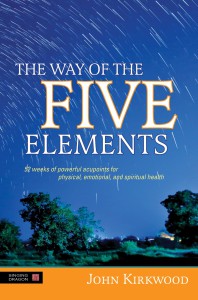 In this blog post, Spencer Hill recalls the process of drawing the cartoons for The Yellow Monkey Emperor’s Classic of Chinese Medicine and how he met and came to work with Damo Mitchell.
In this blog post, Spencer Hill recalls the process of drawing the cartoons for The Yellow Monkey Emperor’s Classic of Chinese Medicine and how he met and came to work with Damo Mitchell.
Acupuncture
Gateways to Greater Health
In The Way of the Five Elements, John Kirkwood references a category of acupoints known as entry and exit points. Here, he elaborates on these points, the timely use of which can make big differences to treatment outcomes.
Qi flows through the 12 organ meridians in a continuous circuit. It flows out of the exit point of one meridian and into the entry point of the next meridian in the Wei Qi cycle. For most of the meridians the entry point is the first point of the meridian. The exit point is either the last point or one close to the end of the meridian.
Entry-Exit Blocks
If work with a client is not holding, there may be a block to treatment and it is worth looking for a possible entry-exit block since these are the most frequently encountered blocks and the most easily treated. Acupressure is well suited to working with these blocks.
An entry-exit block arises when Qi is not flowing freely from one meridian to the next. The blockage of Qi flow between exit and entry point may be partial or complete.
Sometimes a block becomes evident early in treatment, but more commonly, the block occurs during the course of treatment and needs to be addressed in order for the treatment to proceed successfully.
Diagnosing Blocks
The most reliable way to detect blocks is on the pulse where there is a relatively full pulse on one meridian and a relatively deficient pulse on the following meridian. If the pulse is not used, signs and symptoms such as skin eruptions, swelling, pain, constriction, feelings of congestion, fullness or emptiness at the entry-exit points are all suggestive of a block.
In addition, if treatment suddenly becomes less effective or stops working altogether, an entry-exit block may be suspected. An unexpectedly strong reaction during the course of treatment can also indicate a block. This kind of block is caused when an existing block manifests itself as a result of the extra Qi that is made available.
Treating Blocks
When a block is suspected, palpation of the points can confirm the diagnosis. Holding the points, the practitioner may sense a numbness, deadness, emptiness and/or lack of movement either at the entry point, the exit point, or both.
Blocks may be bi-lateral or unilateral. To focus your intention, it is best to work on one side at a time. Begin by holding both the entry and the exit point. Stay with both if both are blocked. If only one is blocked, then hold the one blocked point.
Some points can take a long time to open, and even then reluctantly. When both practitioner and client visualise pulling Qi through, this can aid the process.
More than one treatment may by necessary to resolve a block. Even when the block appears to be resolved, it may reappear later in treatment.
Two Kinds of Blocks
Since there are 12 organ meridians, there are 12 possible blocks. Six of these flow from a meridian into its partner meridian (e.g. Gall Bladder to Liver). The other six flow from a meridian of one Element to a meridian of another Element (e.g. Triple Heater to Gall Bladder).
It is this second kind of block that I want to focus on here since it occurs more frequently, is the greater block to treatment and tends to produce the more serious symptoms.
Large Intestine to Stomach
LI 20 is slightly lateral and superior to the outside base of the nose. Qi flows to ST 1 which lies below the pupil at the orbital ridge. Signs and symptoms can include spots or rashes at LI 20, nasal congestion, sinusitis, difficulty smelling, spots or rashes below the eye, eye spasms, pain or congestion at the eye.
Spleen to Heart
This is one of the more common entry-exit blocks. SP 21 lies on the side of the body, below the armpit in the 7th intercostal space and roughly at the level of the xiphoid process. Qi flows from there to HT 1 which is in the depression at the centre of the armpit. Symptoms can include fullness of the chest, palpitations, pain in the ribcage, depression, fatigue, pain in the armpit, appetite disorders, and spots or rashes at the site of the points.
Small Intestine to Bladder
SI 19 is at the tragus of the ear, in a depression that appears with the mouth open. Qi flows from there to BL 1 which is located at the inner corner of the eye, just above the tear duct. Symptoms can include jaw tension, eye problems, tear duct issues, eye pain and headaches.
Kidney to Heart Protector
K 22 lies in the 5th intercostal space, 2 cun lateral to the midline, flowing to HP 1 which is 1 cun lateral and slightly superior to the nipple in the 4th intercostal space. On women, use HP 2 which is between the heads of the biceps 2 cun below the fold of the armpit. Symptoms can include tension or pain at the side of the sternum or in the breast; rashes, spots or lumps at site of points or in the intervening space; depression, fear and lack of joy for life.
Triple Heater to Gall Bladder
TH 22 is 0.5 cun anterior to the upper border of the root of the ear, on the posterior border of the hairline of the temple, flowing to GB 1 in a depression 0.5 cun lateral to outer canthus of the eye. Symptoms of this block may be frontal and temporal headaches, vision problems, tics and an inability to see the way forward or take action.
Liver to Lung
LV 14 is on the nipple line, in the 6th intercostal space, usually slightly above the level of the xiphoid process. Qi moves from there to LU 1 which is 6 cun lateral to the midline in the 1st intercostal space. Symptoms can be breathing difficulty or constriction, fullness of the ribcage, emotions of grief and anger (often suppressed) and a feeling of being tired and wired.
By becoming aware of the potential for these blocks and clearing them as they arise, practitioners can greatly support their clients’ treatment processes and promote swifter healing.
Learn more about John Kirkwood’s new book The Way of the Five Elements HERE.
Sign up to receive the Singing Dragon Complete Catalogue
 The Singing Dragon Complete Catalogue is now available. With full information on our expanding list of books in Chinese Medicine and Acupuncture, Qigong, Yoga, Aromatherapy, and a variety of other disciplines, our catalogue is an essential resource for complementary health practitioners and anyone interested in enhancing their own health, wellbeing and personal development.
The Singing Dragon Complete Catalogue is now available. With full information on our expanding list of books in Chinese Medicine and Acupuncture, Qigong, Yoga, Aromatherapy, and a variety of other disciplines, our catalogue is an essential resource for complementary health practitioners and anyone interested in enhancing their own health, wellbeing and personal development.
To receive a free copy of the catalogue, please fill out the form below and press subscribe:
Request a copy of the new US Acupuncture & Chinese Medicine Catalog
Our brand new US Acupuncture & Chinese Medicine Catalog is about to mail. If you’d like to receive a free copy, please sign-up for our mailing list and we’ll send a copy ASAP.
Take advantage of this opportunity to see Singing Dragon’s ever expanding list of authoritative books and resources. 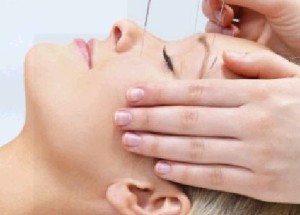 Guohui Liu, M.Med., L.Ac.’s major new translation of the classic Shang Han Lun, Discussion of Cold Damage (Shang Han Lun): Commentaries and Clinical Applications, makes the foundational text fully accessible to English speaking clinicians for the first time. Rainy Hutchinson, an acupuncturist who runs her own clinic in Sheffield, UK, invites students to color and doodle their way through the sequence of images on each channel in her new book, The Acupuncture Points Functions Colouring Book. Longtime Singing Dragon author, Dr. David Twicken DOM, LAc provides a complete exploration of the theories and clinical applications of the Luo Collaterals, and the Shen and the five Shen in his newest book, The Luo Collaterals: A Handbook for Clinical Practice and Treating Emotions and the Shen and The Six Healing Sounds.
Guohui Liu, M.Med., L.Ac.’s major new translation of the classic Shang Han Lun, Discussion of Cold Damage (Shang Han Lun): Commentaries and Clinical Applications, makes the foundational text fully accessible to English speaking clinicians for the first time. Rainy Hutchinson, an acupuncturist who runs her own clinic in Sheffield, UK, invites students to color and doodle their way through the sequence of images on each channel in her new book, The Acupuncture Points Functions Colouring Book. Longtime Singing Dragon author, Dr. David Twicken DOM, LAc provides a complete exploration of the theories and clinical applications of the Luo Collaterals, and the Shen and the five Shen in his newest book, The Luo Collaterals: A Handbook for Clinical Practice and Treating Emotions and the Shen and The Six Healing Sounds.
Click this link to sign-up to our mailing list and receive a catalog which features the above books and more.
For more information on Singing Dragon or to see our complete list of books and resources, please visit: intl.singingdragon.com.
Shōnishin – The Art of Japanese Acupuncture Without Needles
Shōnishin (from Japanese shōni = little child, shin = needling) is a non-invasive method of acupuncture which was developed in Japan for pediatric treatment around 100 years ago. Instead of using needles there are different tools and instruments. They are used for rubbing and tapping on certain reflex zones and meridian areas, as well as on acupuncture points for gentle stimulation along the torso and the extremities.
The therapeutic effect of Shōnishin is to regulate and support the specific development of children, especially the central and autonomous nervous systems. Therefore the treatment is very effective, especially for children with different disharmonies or illnesses from birth to school age. As Shōnishin has no side effects and is absolutely painless, this kind of treatment is made-to-measure for the needs, complaints, and illnesses of babies and children.
Other client groups who can benefit from Shōnishin
Shōnishin is being used as an alternative to acupuncture in women’s shelters, mother-child facilities and nurseries. This aids women and children, who are in difficult social or monetary situations, abandoned and without any obvious way out. This includes traumatized women and children (e.g. survivors of rape), who are only able to permit touching via the “interposed” Shōnishin instrument where no skin-to-skin contact happens.
Another field of application for Shōnishin will be in the treatment of older adults. Particular parameters like skin conditions and mental conditions seem to show retrogression into childhood. First experiences with Shōnishin in homes for the aged show promising treatment approaches. Even here it becomes obvious, that treatment with a Shōnishin instrument is advantageous as older adults often suffer from a shortage of caring touch. With Shōnishin the contact doesn’t take place directly, but indirectly with an instrument. Thus, older adults have no fear of contact and are willing to allow the treatment. Yet another advantage of treating elderly people with Shōnishin is that as many of them have to take blood-thinning medicines, with the non-invasive and gentle treatment technique with Shōnishin, there is no contraindication.
Training in Shōnishin
Training in Shōnishin varies a lot in the way it is done outside Japan. In Germany there are trainers who offer one-day courses. This, of course, entails the risk that therapists with minimal training could bring Shōnishin into public disrepute if they treat children outside their own household.
As a member of the Japanese Scientific Association of Acupuncture for Children (Nihon Shōni Hari Gakkai), my main aim in running courses is to set a high quality standard in the interest of both small and older children. My courses are based on current traditional Japanese medicine research and on Western health sciences on the other.
Knowledge on child development from both Western and Eastern points of view are an essential lesson of the course. Shōnishin training is best acquired after a basic training in a meridian therapy (e.g. acupuncture, Tuina or Shiatsu) and a minimum six days course. Since, ultimately, children are going to be treated, the motor and sensory aspects of child development in the first 12 months of life are taught, as is energetic development. The most important thing is to understand how the meridians develop, and their influence on child development and development in later life.
Theoretical Basics of Shōnishin
I have based my training of Shonishin upon my nearly 30 years’ experience of working with children. My wife, Karin, initially trained as a physiotherapist and and went on to study shiatsu in Japan. In 1985, she and I founded an institute for Complementary and Alternative Medicine just outside Frankfurt, Germany. Karin teaches baby and child shiatsu internationally and is a Founder of the German Shiatsu Society. She has written a number of books on the subject, including Children at Their Best and Baby Shiatsu.
Together, we have developed a mod el of energetic development that can serve as the theoretical foundation for Shōnishin. It is the basis for understanding child development in its energetic aspect, and ultimately for diagnostic and therapeutic processes that depends on the stages of development.
el of energetic development that can serve as the theoretical foundation for Shōnishin. It is the basis for understanding child development in its energetic aspect, and ultimately for diagnostic and therapeutic processes that depends on the stages of development.
The model of energetic development is an attempt to bring the knowledge of modern neuroscience, developmental psychology and developmental physiology into harmony with the knowledge and experience of oriental medicine.
The model states that each energetic stage of motor and sensory development builds on the previous developmental stage. The meridians play a primary role in this and represent a communications network connecting the child with her external world. They are then also responsible for the child’s development of posture, movement, patterns of behavior and personality.
Knowing about the ways motor, sensory and energetic functioning are interwoven, opens up new perspectives on child development, resulting in specific treatment approaches. Ultimately, it is the knowledge of meridians in developmental stages forms the foundation for treatment of children of all ages with Shōnishin.
Shonishin Training with Thomas Wernicke in the UK:
3 day course as part of the 6 day Shonishin Training with Thomas Wernicke:
When: Saturday 30th May to Monday 1st June 2015
Where: Edinburgh
Cost: Early Bird booking by 31st March 2015 £235, full cost thereafter £260
For more information and to book your place (places limited to 12 people) contact:
Svenja Schaper, Shiatsu Practitioner, Dip. BSS, MRSS, PGCE
svenjashiatsu@movingtouch.co.uk mobile: 07842 563 298
~~~
Thomas Wernicke is a licensed General Practitioner with qualifications in complementary medicine, Chinese and Japanese acupuncture, as well as manual therapies including craniosacral therapy and osteopathy for adults, children and babies, psychosomatic therapy and homeopathy. He is a member of the Japanese Scientific Society for Shonishin, and since 2004, he has been the Training Manager for Daishi Hari Shonishin in Europe. Thomas is also Founding Member and President of the International Society for Traditional Japanese Medicine. He lives in Hochheim, Germany. He has written Shonishin: The Art of Non-Invasive Paediatric Acupuncture publishing by Singing Dragon.
5 thoughts from Nora Franglen
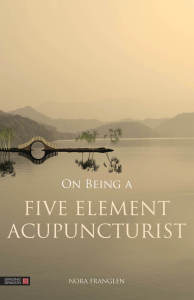 In this extract from On Being a Five Element Acupuncturist, master acupuncturist Nora Franglen shares her thoughts on how much she hates “the placebo effect”, allowing the elements to surprise us, how to deal with “Aggressive Energy”, bringing acupuncture back to China, and a remarkable difference between two elements.
In this extract from On Being a Five Element Acupuncturist, master acupuncturist Nora Franglen shares her thoughts on how much she hates “the placebo effect”, allowing the elements to surprise us, how to deal with “Aggressive Energy”, bringing acupuncture back to China, and a remarkable difference between two elements.
The book is based on her widely-read blog about the wholeness of life as a Five Element practitioner. Nora Franglen’s breadth of interest shows how the curiosity and life experiences of the individual lie at the heart of what makes a true acupuncturist, over and beyond the necessary knowledge and expertise in the technicalities of practice. From her penchant for coffee shops to reflections on challenges she has experienced in the clinic, Nora illustrates how the Five Elements influence, illuminate and, ultimately, enrich all aspects of her life, and vice versa.
Have all of Chinese Medicine in your pocket – interview with Richard Bertschinger
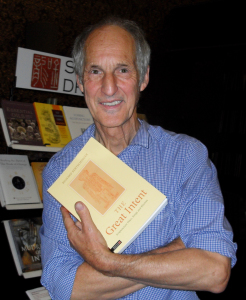 Richard Bertschinger is a practising acupuncturist, teacher of the healing arts, and translator of ancient Chinese texts. He studied for ten years with the Taoist sage and Master, Gia-fu Feng. He talks to Singing Dragon about his groundbreaking translation work, ‘the oldest book in the world’, and having all of Chinese medicine in your pocket.
Richard Bertschinger is a practising acupuncturist, teacher of the healing arts, and translator of ancient Chinese texts. He studied for ten years with the Taoist sage and Master, Gia-fu Feng. He talks to Singing Dragon about his groundbreaking translation work, ‘the oldest book in the world’, and having all of Chinese medicine in your pocket.
Thanks for agreeing to talk to us, Richard, about your five books. I wondered if you could tell our readers something briefly about each and how they came about?
Well these books are really a summation of my Taoist studies over the last thirty years. The titles are worth repeating: The Secret of Everlasting Life, Yijing: Shamanic Oracle of China, Everyday Qigong Practice, The Great Intent and Essential Texts in Chinese Medicine. I was fortunate to meet a Chinese-American Giafu Feng in the ‘seventies who introduced me to the Chinese world of the Tao – really it was from Giafu that I got the inspiration for this work. He was brought up in Shanghai during tumultuous 1920’s in China. In his last few days (he died in 1986) he spoke to me about alchemy – in fact it was his overwhelming concern that I should work on making the idea of alchemical practice available to the West. And I knew nothing about it! So I dived into what was in translation at that time. There was actually very little. The oldest work, written in the 2nd century AD was this text – which I have presented as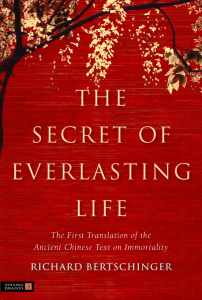 The Secret of Everlasting Life. It is primarily a Qigong manual, in fact the very first to be written, anywhere in the world! So I cut my teeth on this and its Chinese commentaries. All my work is based upon my reading of the Chinese commentaries – and on how they were explained to me by Giafu. In this I think I was blessed, in having the ‘key’, as it were – his oral instruction – to unlock this extremely intricate puzzle.
The Secret of Everlasting Life. It is primarily a Qigong manual, in fact the very first to be written, anywhere in the world! So I cut my teeth on this and its Chinese commentaries. All my work is based upon my reading of the Chinese commentaries – and on how they were explained to me by Giafu. In this I think I was blessed, in having the ‘key’, as it were – his oral instruction – to unlock this extremely intricate puzzle.
What do you mean, then, by this ‘intricate puzzle’?
Actually this puzzle is just the Chinese Mind! I feel strongly that the Chinese ideas and skills, knowledge and techniques (including acupuncture) should be taken within their own context – you cannot just import techniques and not understand the background teaching and philosophy. It really will not work.
You are referring to acupuncture perhaps? Where more ‘medical’ acupuncturists, such as doctors and nurses use acupuncture without a full apprenticeship?
 Not really, I think that acupuncture can survive any usage. It is resilient enough! But certainly without the dedication of a three year training you are not going to be using its full potential. And you are not giving patients the best either! Anyway, this leads on to The Great Intent, which is actually a re-working of The Golden Needle, a book published earlier in 1991. Singing Dragon was quite keen to reprint this, so I expanded and rewrote the introduction. This is a first translation of many of the odes, song and poems which have, for centuries, been used in teaching acupuncture theory and technique. Again I was keen to get all these ideas out to medical practitioners, who wanted to begin exploring some of the greater subtleties of needling – as well as brush up their theoretical knowledge. I know these poems have proved an inspiration to many.
Not really, I think that acupuncture can survive any usage. It is resilient enough! But certainly without the dedication of a three year training you are not going to be using its full potential. And you are not giving patients the best either! Anyway, this leads on to The Great Intent, which is actually a re-working of The Golden Needle, a book published earlier in 1991. Singing Dragon was quite keen to reprint this, so I expanded and rewrote the introduction. This is a first translation of many of the odes, song and poems which have, for centuries, been used in teaching acupuncture theory and technique. Again I was keen to get all these ideas out to medical practitioners, who wanted to begin exploring some of the greater subtleties of needling – as well as brush up their theoretical knowledge. I know these poems have proved an inspiration to many.
Now tell us a little about Yijing: Shamanic Oracle of China. I understand the Yijing has been referred to as ‘the oldest book in the world’. How can you justify such a statement!
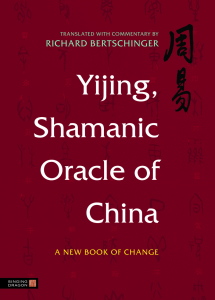 Because the Yijing has its origins, and no one would deny this, in the oracle bones, the scapula of oxen, tortoise shells and the like, which have been unearthed recently in China. These prove that an oracle much like the Yijing (or ‘Book of Change’) was in use some 3000 years ago, in Bronze Age China. The Yijing is all about communicating with the unseen and unsaid. It is an oracle, yes, but also has a philosophy around it of Yin and Yang, the flux within the universe, light and dark, day and night, winter and summer, and the life and death of all living things. It is thus at the threshold of putting an understanding of these things into words – it uses images to communicate ideas, on the borderline of thought, as it were. And this was all happening 3000 years ago, before there were any books! So unlike the Dead Sea Scrolls or Egyptian Scriptures, the Yijing was trying to be useful – not trying to hand down a received wisdom, or deal of concepts. It was about meaning. About the meaning of life, about greatness – about what it is to be human! Like so much of Chinese philosophy, it told us how to live.
Because the Yijing has its origins, and no one would deny this, in the oracle bones, the scapula of oxen, tortoise shells and the like, which have been unearthed recently in China. These prove that an oracle much like the Yijing (or ‘Book of Change’) was in use some 3000 years ago, in Bronze Age China. The Yijing is all about communicating with the unseen and unsaid. It is an oracle, yes, but also has a philosophy around it of Yin and Yang, the flux within the universe, light and dark, day and night, winter and summer, and the life and death of all living things. It is thus at the threshold of putting an understanding of these things into words – it uses images to communicate ideas, on the borderline of thought, as it were. And this was all happening 3000 years ago, before there were any books! So unlike the Dead Sea Scrolls or Egyptian Scriptures, the Yijing was trying to be useful – not trying to hand down a received wisdom, or deal of concepts. It was about meaning. About the meaning of life, about greatness – about what it is to be human! Like so much of Chinese philosophy, it told us how to live.
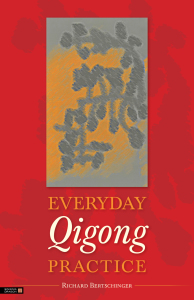 Well, that is quite a topic. The last two books you mentioned about are Everyday Qigong Practice…
Well, that is quite a topic. The last two books you mentioned about are Everyday Qigong Practice…
That one ‘does what it says on the tin’. It is a simple introduction to Qigong exercises, with brilliant diagrams by Harriet Lewars – you can pick it up, and seconds later be practicing qigong, and circulating the Qi.
And the last, Essential Texts in Chinese Medicine: The Single Idea in the Mind of the Yellow Emperor?
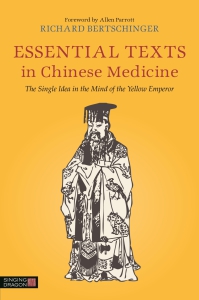 This is my latest book. It is a digest of the medical writings contained in the Huangdi Neijing, or Yellow Emperor’s Book of Medicine, the great compendium of medical studies produced during the Han, and which has provided the backbone of all traditional medicine in the East for the last two-thousand years. I was fortunate, again, to pick up a copy of a condensed version of this book in 1981 at Stillpoint, Colorado, where I was studying with Giafu Feng – and he started me off with some tape recordings, he would get up 4 am, make a large pot of Earl Grey tea, which we would share and off he would go, extemporising a translation ‘on the hoof’ as it were of this book. Page One, Chapter One. It took him perhaps three months to finish, and I had to leave before it was done, but the next spring I remember him arriving at Heathrow airport with a large carrier bag in his hand, ‘here you are Richard the Book of Medicine, finished!’ There was no way I could turn down a commission such as this! So I have been working at producing a readable version of this text. Firstly I translated the Chinese commentaries, most from the Ming and Qing, then I collated them with his version. Then I also interleaved my own acupuncture studies and notes from Jack Worsley’s teachings and finally, after many years work, I have a version which I think is just about ready to go to press. It grew in the making, but from quite early on I saw that there was one thread running through the whole – this is obvious to anyone who begins to read the book. This one thread I rather grandly name ‘the single idea’ – really it describes the workings of Yin and Yang and the Five Elements. Once you can get a handle of what they are talking about and how they work, you really do have Chinese medicine ‘in your pocket’, as it were.
This is my latest book. It is a digest of the medical writings contained in the Huangdi Neijing, or Yellow Emperor’s Book of Medicine, the great compendium of medical studies produced during the Han, and which has provided the backbone of all traditional medicine in the East for the last two-thousand years. I was fortunate, again, to pick up a copy of a condensed version of this book in 1981 at Stillpoint, Colorado, where I was studying with Giafu Feng – and he started me off with some tape recordings, he would get up 4 am, make a large pot of Earl Grey tea, which we would share and off he would go, extemporising a translation ‘on the hoof’ as it were of this book. Page One, Chapter One. It took him perhaps three months to finish, and I had to leave before it was done, but the next spring I remember him arriving at Heathrow airport with a large carrier bag in his hand, ‘here you are Richard the Book of Medicine, finished!’ There was no way I could turn down a commission such as this! So I have been working at producing a readable version of this text. Firstly I translated the Chinese commentaries, most from the Ming and Qing, then I collated them with his version. Then I also interleaved my own acupuncture studies and notes from Jack Worsley’s teachings and finally, after many years work, I have a version which I think is just about ready to go to press. It grew in the making, but from quite early on I saw that there was one thread running through the whole – this is obvious to anyone who begins to read the book. This one thread I rather grandly name ‘the single idea’ – really it describes the workings of Yin and Yang and the Five Elements. Once you can get a handle of what they are talking about and how they work, you really do have Chinese medicine ‘in your pocket’, as it were.
Winter Water Element Activities for Children
Welcome back to the monthly series of stimulating Five Element activities that can support development of children in all ages! If this is your first time reading our blog, you can go back to our first entry in May to view the WOOD Element activities. All of the blogs can be downloaded in a pdf format by clicking on the link at the end of this article so that you can enjoy making your own notebook of Five Element exercises for each month and season of the year.
 Brrrr… Winter winds and frosty mornings bring the natural contraction of our muscles and bodies to conserve our energy and find a warm cozy place to warm our hands and feet. Winter represents the Element of Water, the source of our life energy and keeper of our reservoirs. All around us nature shows us that earth has her natural cycle of decline and rest in the winter season, with the hibernation of the animals and foliage in snowy lands, and the decline of growth and fruits in the tropical regions. Winter shows us the two sides of the life force through its pure, silencing, stillness that takes us deep into our unconscious minds and souls, to the raging power of a glacier or iceberg cutting through the earth and leaving its imprint for all of life to spring forth from.
Brrrr… Winter winds and frosty mornings bring the natural contraction of our muscles and bodies to conserve our energy and find a warm cozy place to warm our hands and feet. Winter represents the Element of Water, the source of our life energy and keeper of our reservoirs. All around us nature shows us that earth has her natural cycle of decline and rest in the winter season, with the hibernation of the animals and foliage in snowy lands, and the decline of growth and fruits in the tropical regions. Winter shows us the two sides of the life force through its pure, silencing, stillness that takes us deep into our unconscious minds and souls, to the raging power of a glacier or iceberg cutting through the earth and leaving its imprint for all of life to spring forth from.
The Water Element provides the same instincts to our bodies, minds, and spirit as it gives expression to our need and capacity for rest, relaxation and rejuvenation. This inward movement is what cultivates the resources of our energy and reserves for all growth and development in our lives. In children, the Water Element is most obvious when they express a whiny, cranky hour where we know they need a nap, or quiet time to allow their bodies to integrate a busy or exciting day. Some children will just quietly disappear to a resting spot or activity on their own, while others might show bursts of energy until they drop suddenly into a sleep. And then there are those children that seem to have an endless, steadfast flow of energy, with no peaks or valleys, just a consistent capacity to move from one activity to another…
Respecting and sensing the natural rhythm of our children’s life force and need for rest is important, as it builds the foundation of one’s ability to relax and rest in life. The following exercises are examples of some winter/Water Element activities that can be enjoyed with a family, group, or one on one with a child.
Calm Water
Supplies: a lot of newspaper and a little bell (or jingle bells found at Christmas time)
If working with a group or family, everyone but one person lays down on their stomach, while the person/child left standing covers everyone with newspaper sheets from head to toe. The individuals lying down have to remain perfectly still, not moving the paper or making a sound. The person left standing silently walks around trying to surprise the quiet still ones with a sound or stomp, giving lots of room for those lying down to listen sharply and be very still for the approaching noise maker! After this fun and anticipating game, the person left standing rings the bell and everyone jumps up shaking the paper sheets off their bodies. The person with the bell chooses the next person to be the bell keeper and the game can begin again.
Getting Taller
Divide everyone in the group into pairs, and have one partner face the back of the other partner. The person facing the back of their partner asks them, what kind of rain they want to fall on their back; a soft spring rain, powerful summer thunder storm, or gentle snow falling down. The rain maker then makes a soft, loose fist, or flexible fingertips, and taps down the back on the right and left side of the spine, all the way down to the feet (the Bladder Meridian in the Water Element). It is important to always start from the top and tap down toward the feet, like the rain or snow falling down the body. Repeat 2 times, and always start from the top again. When done raining, “dry” the back with flat hands down the back from shoulders to feet, and then change roles.
This is also fun, if a group stands in a line and everyone behind the other in the line tries to do this at the same time, then reverse the direction of the line.
Click this link to download this article.
For more information about the Five Elements and the way they can support child development, read Children at Their Best: Understanding and Using the Five Elements to Develop Children’s Full Potential for Parents, Teachers, and Therapists released in 2014 with Singing Dragon.
Last post dates for Christmas 2014
If you would like to receive your purchases in time for Christmas 2014 we recommend placing your order before midnight on the following dates (depending on which country you want to ship to)
USA – 12th December 2014
UK – 15th December 2014
Australia – 15th December 2014
New Zealand – 5th December 2014
We regret that we cannot provide accurate dates for other countries but if you email hello@intl.singingdragon.com or call +1 215 922 1161 (USA) or +44 (0)20 7833 2307 (UK and rest of world) we will do our best to find out for you. If you miss the last post dates it may be possible to express deliver your order, please call or email to find out.
Have a merry Christmas and a happy New Year from everyone at Singing Dragon!
Five myths about Chinese medicine most patients believe
by Angela Hicks
 When you hear the words ‘Chinese medicine’ what comes to your mind? I bet you think of acupuncture! Most people do. But in fact there are five therapies included in Chinese medicine.
When you hear the words ‘Chinese medicine’ what comes to your mind? I bet you think of acupuncture! Most people do. But in fact there are five therapies included in Chinese medicine.
The five strands of Chinese medicine are:
- Acupuncture
- Chinese herbs
- Tuina (massage)
- Qigong (exercises)
- Dietary therapy
In my book Principles of Chinese Medicine I explain how each of these treatments are used, and I give lots of examples – so if you are thinking of seeing a Chinese medicine practitioner you will know exactly what to expect. All of these therapies have been tried and tested over thousands of years – and the research base from China and the West is extensive too – proving to us how well they work.
The truth about acupuncture needles
Acupuncture is the most well-known Chinese medicine treatment (which is why you probably thought of it first!) and perhaps the most frequently practiced in the West. Acupuncture is enjoyed by millions of people throughout the world and the benefits are huge. Sadly some people miss out on its benefits because they are afraid that needles will be painful. So what is the truth about needles?
The good news is that needles create a dull sensation rather than pain. In my book some patients give descriptions such as a ‘tingling feeling’, a ‘dull ache’ or a ‘pulling sensation’. Unlike when you see a dentist, which many people dread, patients are likely to enjoy visiting their acupuncturist. They find treatment improves their well-being as well as curing their illnesses.
On top of this, a practitioner will use only a few very fine needles (and by the way, those awful photos of people with hundreds of needles in them are sensational and not realistic). And finally, of course, all practitioners use impeccable standards of hygiene and all needles are disposable and used only once.
So if you want treatment and were put off by the thought of needles – maybe think again!
The truth about Chinese herbal medicine
There are still rumours that Chinese herbalists use animal products in their prescriptions, and also products that come from endangered species. Not true! In the West the use of animal products is not only prohibited but practitioners don’t even want to use them. The Register for Chinese Herbal Medicine, one of the largest Chinese herbal medicine professional bodies, says on its website, ‘we strongly condemn the illegal trade in endangered species and have a strict policy prohibiting the use of any type of endangered species by any of our members’.
Chinese herbs effectively treat many conditions and are used extensively in most Chinese hospitals. Why are they used so much? Because they have been keeping Chinese people healthy for thousands of years. So maybe they could help you too – and you won’t be harming any animals in the process, only helping yourself.
Some dietary therapy truths
The final therapy in Chinese medicine is dietary therapy. This is an age-old system of dietary advice that has been handed down through generations. Dietary therapy is consistent, logical and tried and tested. In China many people are conscious of what constitutes a healthy diet. In contrast, in the West advice is constantly changing – the latest food ‘fad’ tells us to eat more meat, or more carbohydrates, or that fat is bad for you – or maybe good for you. We are inundated with conflicting information. We are confused and no wonder. There is a myth that Chinese dietary therapy is just another fad. No it isn’t. Chinese dietary therapy gives us a way of eating that is simple, nourishing and can keep us healthy for life.
The truth about Chinese massage treatments
When we think of massage we often think of relaxation. Patients who have Chinese massage say it is very relaxing in fact they may leave treatment as if floating on cloud nine! There is, however, a myth that this is all it can do. But there is much more to it than this. Tuina massage (pronounced twee nar) is also a very effective system of treatment. It not only deals with joint problems which you might expect, it can also help many other conditions including digestive complaints, lung illnesses, gynecological problems and much more.
In my book you will read the story of a patient cured of a stomach problem she had had for over 20 years that no one else could help! So if you come to have some tuina don’t rule out a miracle from that as well!
The truth about qigong practice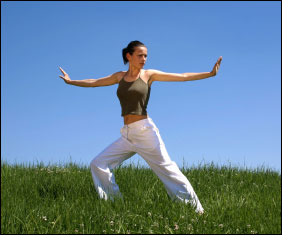
Qigong (pronounced ‘chee gong’) is an umbrella term that covers a vast array of Chinese exercises including tai chi. They are not the usual exercises you might do. These exercises are gentler and are performed more slowly than exercises performed in a gym. And you’ll have different results from practicing them than from going to the gym. The most common myth is that qigong is so gentle that it is less effective than vigorous exercise. Somehow we feel we must do something and maybe push a bit to know exercise benefits us. When you do qigong you might not even feel you are doing much. These exercises have, however, been shown to have a profound effect on people’s health. For example, here are results from studies into the psychological and physiological effects of qigong and tai chi covering a total of 6410 participants from 13 countries: Effects included improved bone strength, better lung and heart fitness including lower blood pressure, improved overall physical functioning, prevention of falls and improved balance. They also create better immunity, an improved general quality of life and a positive change in psychological factors such as general well-being, anxiety and depression.
So who says you have to work hard to get results? There’s another saying – doing less is doing more – and in the case of qigong it’s very true.
Now that you know a little more about Chinese medicine you might have a dilemma. Which one do I choose? I’m afraid you’ll have to make the choice yourself! If you want more information, my book Principles of Chinese Medicine might help you decide.
